forensic and mental health 5-8 flashcards
1/98
There's no tags or description
Looks like no tags are added yet.
Name | Mastery | Learn | Test | Matching | Spaced |
|---|
No study sessions yet.
99 Terms
explain reading vs critical appraisal (READING)
comprehension: understanding the meaning of the words and sentences
interpretation: grasping the underlying concepts, ideas, and implications of the text
analysis: examining the structure of the argument, the flow of the narrative, or the organisation of information
synthesis: integrating information from different parts of the text or combining insights from multiple readings to form a new understanding
explain reading vs critical appraisal (CRITICAL APPRAISAL)
evaluation: assessing the quality and credibility of the text. for scholarly articles, this includes methodology, data collection, and analysis
critique: identifying strengths, weaknesses, biases, and gaps in the context or argument
contextualisation: understanding the text in relation to its broader context, such as the current state of research in the field or its socio-cultural background
reflective judgement: formulating an informed opinion on the text based on evidence and reasoning, rather than on preconceptions or emotional responses
application: considering the practical implications of the information and its potential uses
what are the theories of offending?
biological: (e.g. physiological characteristics, heredity, brain studies)
psychological: eysenck's criminal personality
life-course theory (Moffit)
self-control
social: e.g. social learning theory bandura - behaviour learned via observation/reinforcement
theoretical limitations: integrated biopsychosocial models needed
explain the biological disposiution to crime - interactive effect (Mednick et al, 1983)
- Looked into children's with their biological parents and others with their adoptive. If the parents had a criminal background
- They are trying to apply that criminality can be linked to your genes.
- 13.5% still likely even with non-criminal so clearly there is something else also there.
Eysenck's criminal personality (1964, 1976)
socialisation occurs through development of a 'conscience' via classical conditioning (e.g. Pavlov and his dogs)
people differ in how conditioned (biological determined - ANS/cortices)
-> Extraversion (E) (under aroused) -- introversion (over aroused)
-> Neuroticism (N) (moody, anxious)
-> Psychoticism (P) (solitude, lack feelings for others, aggression)
Introverts condition quickly: Low E+Low N so less likely to offend?
Extraverts more slowly: socialisation affected - High E + High N = antisocial (least likely to learn social control) most likely to offend? (Overrepresented in offending populations?)
High P, High E, High N = strongest antisocial propensity?
Evidence and critical appraisal for criminal personality theory evidence
evidence:
- studies generally support P & N - offenders generally score high on P/N
- evidence for E is mixed - some support, others don't
critical appraisal:
- doesn't explain types of crime
- other personality factors? e.g. conscientiousness
- other individual differences (e.g. impulsivity, self-control)
- social drivers?
explain Moffitt (1993) Life Course Theory
developmental explanation
- offending either marked by continuity or change
life-course persistent offenders
- small group, antisocial behaviours in childhood (continue to adulthood)
adolescence-limited offenders
- larger group, antisocial behaviours in adolescence, desist in adulthood
different causes for each
- LCP = neurobiological deficits (at risk)
- AL = consequence of adolescent development
self-control - theory of crime
"... the essential element of criminality is the absence of self-control. persons with high self-control consider the long-term consequences of their behaviour; those with low self-control do not. such control is learned, usually early in life, and once learned, is highly resistant to change."
----->People with high self control are less likely to offend and those with loss self control are more likely
----->Self control is something learned in early life and once it is learnt it is highly resistant to change
What is a risk factor?
- increases your chances of some outcome e.g. disease, criminality etc
- predicts an increased probability of later offending
- risk can come from:
1) something you do (e.g. associating with antisocial peers)
2) nothing you do (e.g. having a criminal father)
explain the 3 different types of risk factors
individual factors
- hyperactivity & impulsivity
- intelligence and attainment
family factors
- child-rearing methods
- young mothers and child abuse
- parental conflict and disrupted families
social factors
- socioeconomic status
- peer influence
- neighbouring factors
explain Hoge et al (1996)
- delinquent youths-criminal activity, reoffending and adjustment
- strongest risk factors: family relationships, parenting problems (more re-offending)
- strongest protective factors: positive peer relationships, good school achievement, effective use of spare time, positive response to authority
Operated separately, either high risk or low risk. Good protective factors didn't seem to mediate the risk-worrying.
what other risk factors are there?
- social (family circumstance)
- family history
- environmental
- delinquent peers
- school
- biological (genetics)
- psychological (internal to person)
- mental health (Dep, anxiety, low self esteem)
- personality disorders (CD, ASPD)
- adjustment to life events (linked to psych)
- developmental (Moffitt, 1993 life course theory)
assessing risk factors issues: all studies
1) ethics: sensitive issues
2) age: developmental stage, diagnosis
3) willingness to disclose
- personal issues: abuse
- emotional literacy
- legality (e.g. substance abuse)
- general self-report
4) literacy and learning difficulties
solutions:
- confidentiality
- audio-computer assisted self-interview (ACASI)
- informed consent, mood repair, sources of support/referral
what are the types of studies?
prevalence: e.g. factor X currently in offender populations (e.g. subs abuse)
retrospective: e.g. factor X in past (e.g. child abuse)
controlled: e.g. factor X in offender population vs. factor X in non-offending population
prospective:
- longitudinal: follow a group over time
- cohort: follow several groups over time
explain overview of Dixon et al (2004)
study type: prevalence (with comparison group)
participants: 100 female juveline offenders vs. 100 matched (on age & SES) comparison group
explain the significant differences in Dixon et al (2004)
conduct disorder
- 91% offenders vs. 1% non-offenders
substance abuse
- 85% offenders vs. 5% non-offenders
alcohol abuse/dependence
- 56% offenders vs. 1% non-offenders
depression
- 55% offenders vs. 25% non-offenders
PTSD
- 37% offenders vs. 4% non-offenders
Explain Dixon et al (2004): Trauma exposure
many sig differences
car accident
33% offenders vs. 11% non-offenders
fire
11% offenders vs. 1% non-offenders
witness to violent crime
70% vs. 30%
victim of violent crime
30% vs. 4%
witness to domestic violence
52% vs. 15%
physical abuse
49% vs. 9%
sexual abuse
59% vs. 6%
dixon et al (2004): family/social factors
living in intact family
16% offenders, 57% non offenders
homeless, in care, live independently or with extended family
50% vs. 5%
dixon et al (2004) factors associated with offender status
factors that significantly increase likelihood of offender status:
- exposure to 3 or more traumatic events
- being aboriginal
- living with family other than both biological parents
- living away from family
- mental health is a predominant factor
explain haapasalo and kankkonen (1997): retrospective example
study type: retrospective interview study, with 'comparison group'
participants: sex offenders (rapists)(n = 16) and violent offenders (n = 16) mean age = 36 yrs
selection: offenders randomly sampled from prison ppopulation. comparison group matched on childhood family problems index
explain Trzesniewski et al, 2006
- self esteem and health, criminal behaviour, economic prospects
- adolescence predicting adulthood
- rosenberg (1965) self esteem scale (RSE)
- n = 978 participants
- low self esteem = poorer mental/physical health, low economic prospects, less earning power, more criminal behaviour in adulthood
- findings could not be explained by adolescent depression, gender, or socioeconomic status
- low self-esteem during adolescence predicts negative real-world consequences during adulthood
Rehabilitation
Process aimed at reintegrating offenders into society.
Punishment
Consequences imposed for wrongdoing to deter behavior.
Risk factors
Conditions increasing likelihood of offending behavior.
Age of criminal responsibility
Legal age determining when a child can be prosecuted.
James Bulger case
1993 incident influencing age of criminal responsibility.
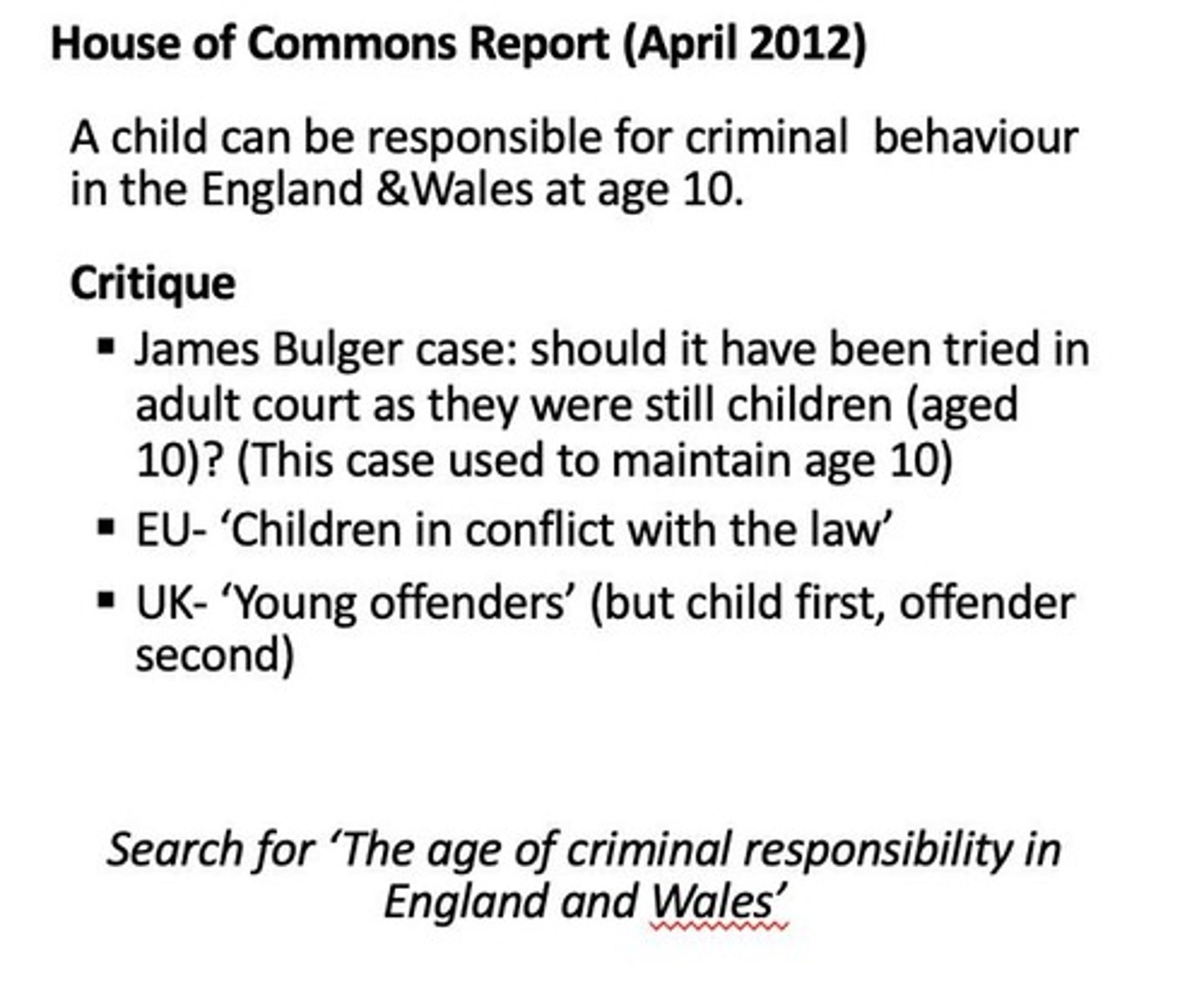
EU approach
Focus on children's rights in legal conflicts.
UK approach
Prioritizes child welfare over labeling as offenders.
Re-offending rate
60% of young offenders repeat offenses.
Labelling theory
Concept that labels influence behavior and identity.
Anti-social Behaviour Act (2003)
Legislation allowing fostering requirements in supervision orders.
Multi-Dimensional Treatment Foster Care (MTFC)
Evidence-based intervention for young offenders' rehabilitation.
Intensive Fostering (IF)
UK adaptation of MTFC for serious behavioral issues.
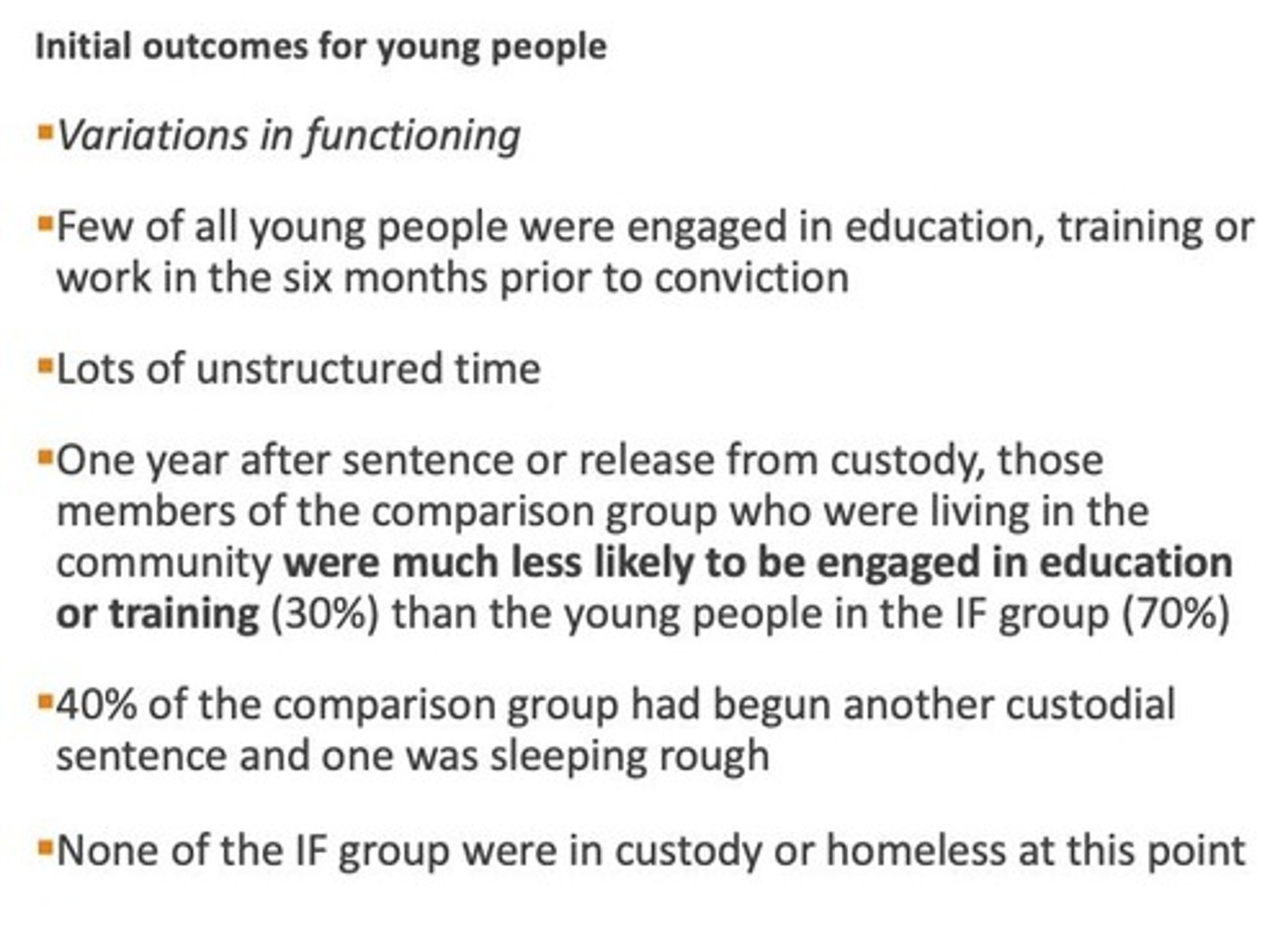
Peer relations
Influence of peers on young offenders' behavior.
Her Majesty's Young Offender Institution (HMYOI)
Prison for offenders aged 18 to 20 in UK.
Secure Children's Home
Facility for offenders under age 15 in UK.
Young Offender Institution
Facility for offenders aged 15 to 20 in UK.
Evidence-based practice
Using research to guide treatment decisions.
Systematic reviews
Comprehensive summaries of research findings on interventions.
Randomised controlled trials (RCTs)
Experimental studies comparing intervention effects.
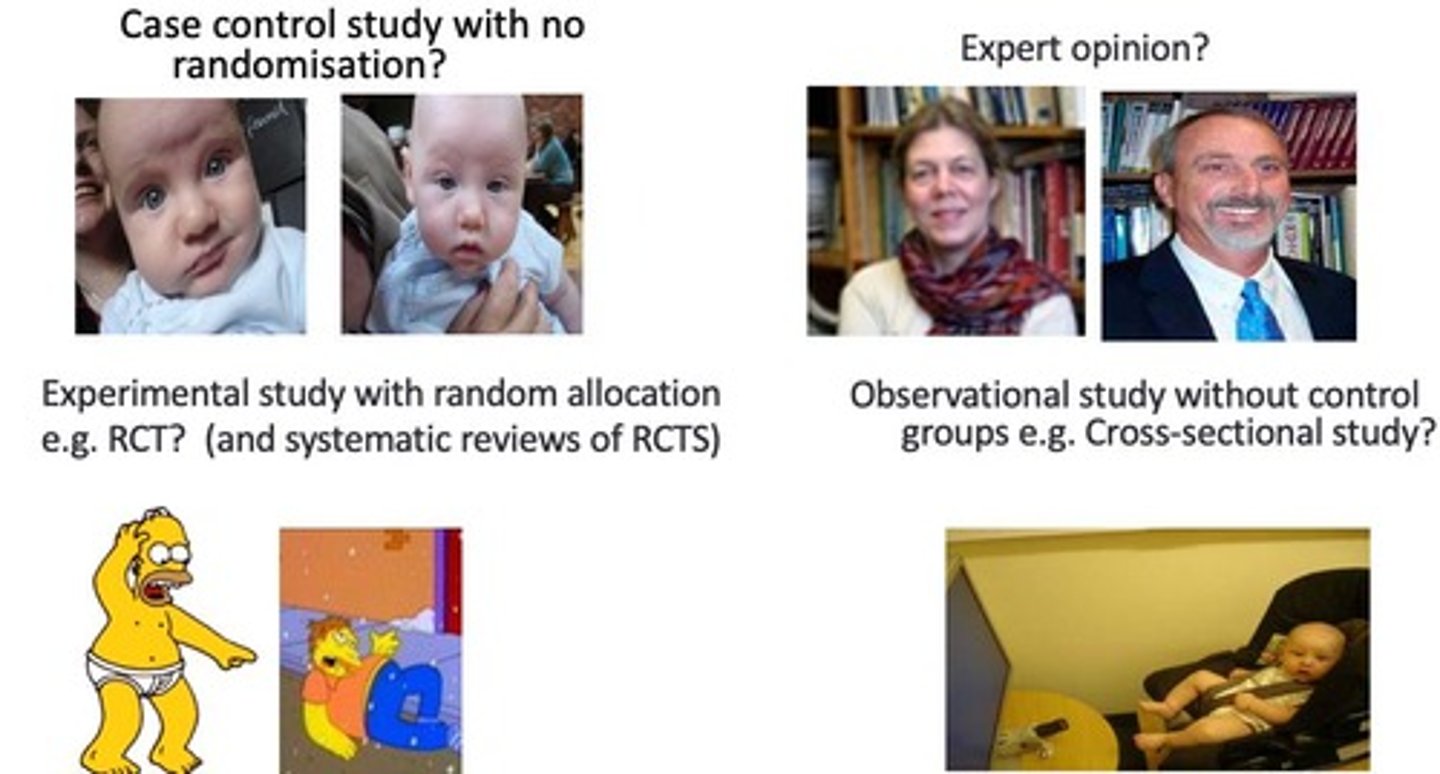
Bias in research
Systematic error affecting study results.
Multisystemic therapy (MST)
Intervention addressing multiple systems influencing youth behavior.
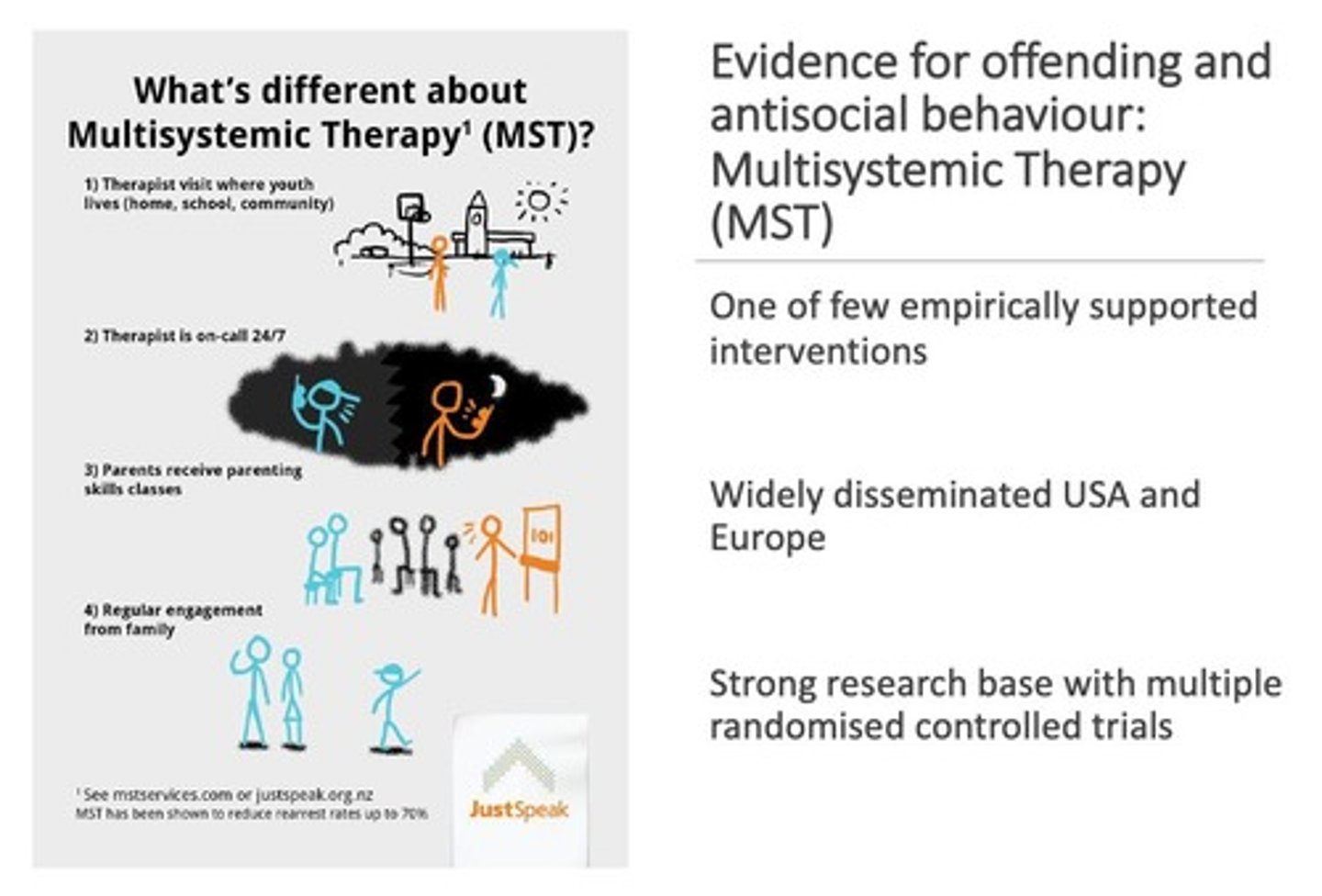
Liaison and Diversion
Service reducing offending through early intervention.
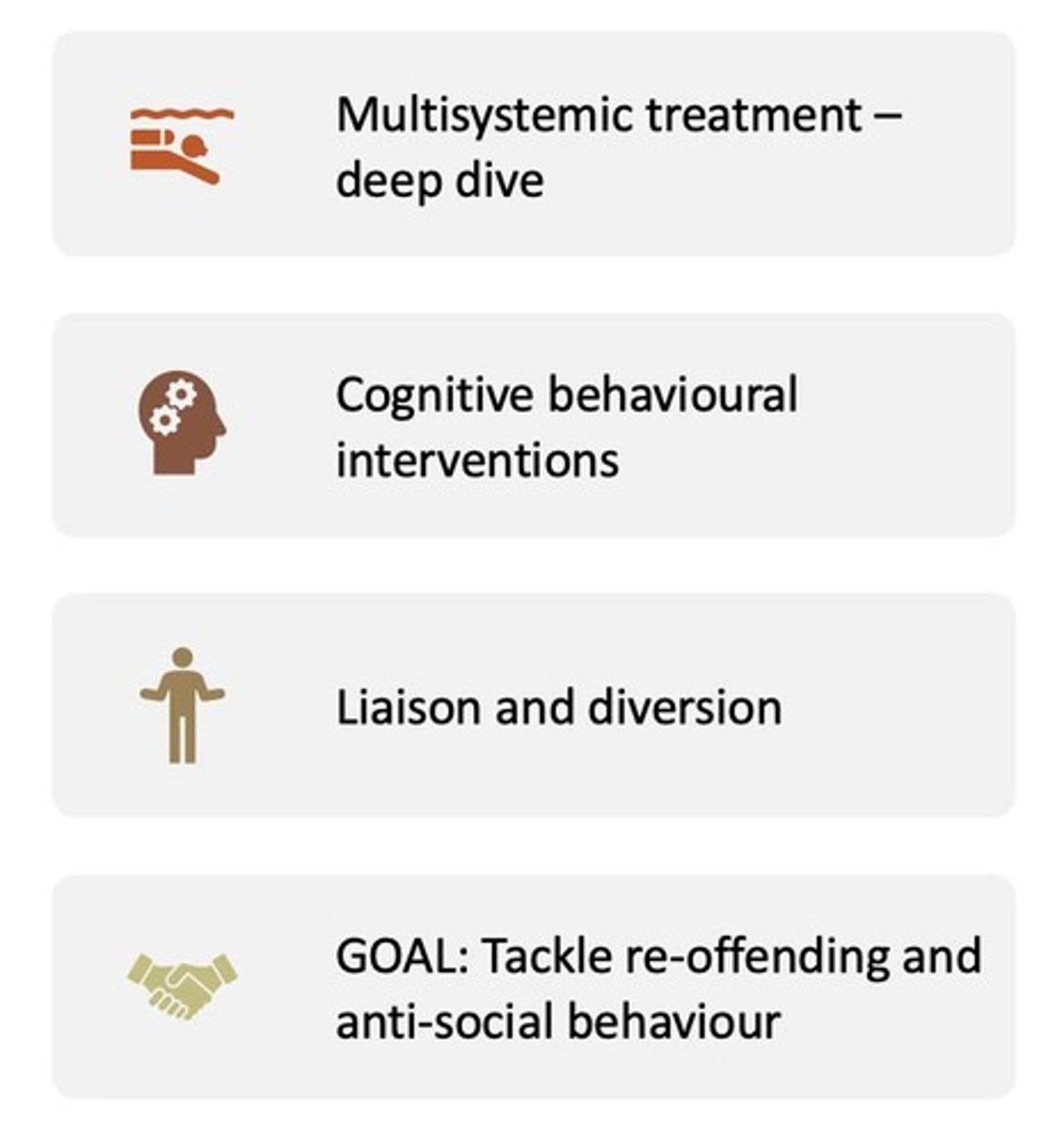
Causality in studies
Determining if one factor directly influences another.
Outcome measures
Metrics assessing effectiveness of interventions.
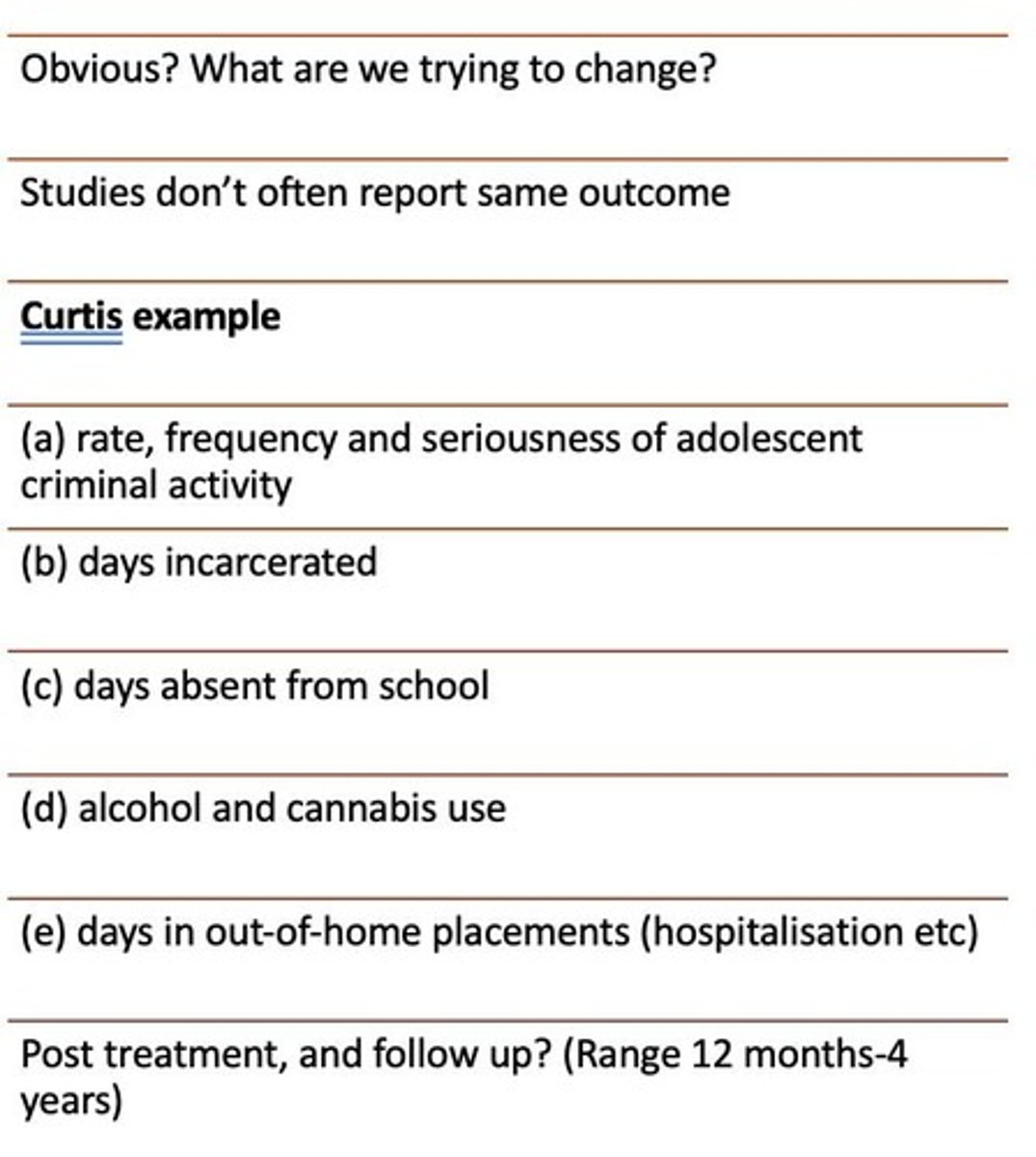
Explain the age of criminal responsibility and critique
House of Commons Report (April 2021)
- A child can be responsible for criminal behaviour in England & Wales at age 10.
Critique
- James Bulgar case: should it have been tried in adult court as they were still children (aged 10) - this case is used to maintain age 10)
- In this case a toddler (James Bulger) was murdered by two 10-year-old boys in 1993.
What are the alternatives to court and prison for young offenders?
- Anti-social Behaviour Act (2003) enabled courts to include a fostering requirement as part of a Supervision Order
- Used in cases where young people's behaviour was to a large extent due to their home circumstances and lifestyle.
- YJB (2005) commissioned agencies in three parts of England to pilot the evidence-based intervention Multi-Dimensional Treatment Foster Care (MTFC) model
- Replication of approach in Oregon Social Learning Centre (OSLC) in USA
- Now known as Intensive Fostering (IF) in UK.
What is the Staffordshire Intensive Fostering Programme?
- Suported by YJB
- Alternative to receiving a custodial sentence
- Helps young people build on skills and knowledge
- Live with experienced foster carers
- Talk to people about their issues
- Rules: Tell carers where they are, bag searches, not allowed to use drugs, attend an education/training programme
- Rates of re-offending 33% opposses to 66%
Explain the Pilot study report (2010)
Initial outcomes for young people
- Variations in functioning
- Few of all young people were engaged in education, training or work in the six months prior to conviction
- Lots of unstructured time
- One year after sentence or release from custody, those members of the comparison group who were living in the community were much less likely to be engaged in education or training (30%) than the young people in the IF group (70%)
- 40% of the comparison group has begun another custodial sentence and one was sleeping rough
- None of the IF group were in custody or homeless at this point
What are the options for young people who offend?
- YOTS (Youth Offending Team) community orders e.g. Intensive Supervision and Surveillance Programme (ISSP) (tagging etc.)
- Secure Children-s Homes (10-14 yrs)
- Young Offender Institution (YOI) (15-17 yrs)
- Secure Training Centre (up to 17 years)
- Prison (>18 yrs)
- Liaison and Diversion
-> MH/substance abuse - refer to services
-> reduce offending and MH problems
-> Educate
What are Randominsed controlled trails? (RCTs)
They are the most rigorous way to determine cause-effect relation exists between treatment and outcome
- Randomisation: random allocation to intervention groups
- reduce bias in RCTs by: allocation method which conceals allocation from the clinician (allocation concealment)
Blinded: outcomes/treatments
- Analysed with patients within the groups as allocated irrespective of whether received treatment (intention to treat analysis).
- Estimate the size of the difference on pre-specified outcomes between
What is bias?
Will often rate the assessment method as 'low risk', 'high risk', or 'unclear'
1) Randomization (random sequence generation) (coin tossing, throwing dice, shuffling cards)
2) Allocation concealment (Done by CTU, numbered drug containers, opaque sealed envelopes)
3) Blinding of participants (and/or personnel)
4) Blinding of outcome assessment (outcome assessors knowing about the intervention group)
5) Incomplete outcome data (attrition bias- who has dropped out and why?)
6) Selective reporting (only some parts of the study have been reported)
What is Multisystemic Therapy (MST)?
Multifaceted, short-term, community-based.
1) Therapist visit where youth lives (home, school, community)
2) Therapist is on-call 24/7
3) Parents receive parenting skills classes
4) Regular engagement from family
Main goals of MST?
- reduce criminal activity in young people and antisocial behaviour such as drug abuse and sexual offending
- decreasing rates of incarceration and out-of-home placements
Target needs of young offenders and families
IMPROVE
- parents discipline practices
- family-community relations
- school/vocational performance
INCREASE
- family affection
- association with pro-social peers
DECREASE
- association with deviant peers
What are the 9 MST Treatment Principles (Henggeler et al, 1998)
1) Finding the Fit (How problems fit in with environment)
2) Focusing on positives and strengths (Protective factors, strengths, hope, using what's already there)
3) Increasing Responsibility (With everyone)
4) Present-focused, action-oriented & well-defined (Specific and well-defined problems)
5) Targeting Sequences (Patterns of beh the sustain problems)
6) Developmentally Appropriate
7) Continuous effort (comminittment, evaluation of outcomes over a long period of time, different times)
8) Evaluation & Accountability (Doesn't label, avoids blame)
9) Generalization (Family members drive the change)
Explain background of Littell, Popa & Forsythe (2005)
- 1985-2003 search (and experts were contacted)
- youth (age 10-17) with social, emotional, and/or behavioural problems
- randomised to licensed MST programs vs usual services or alternative treatments
-8 studies were eligible for inclusion
Results of Littell, Popa & Forsythe (2005)
No significant effects of MST on the likelihood or duration of restrictive out-of-home placements, proportion of youth who were arrested or convicted, or numbers of arrests/convictions (1-years post-intervention)
- no sig diff on drug tests or self-reported drug use at a 6-month follow-up
- post-treatment data for program completers, no sig between-group differences on
-> self-reported delinquency
-> peer relations
-> youth behaviour problems/psychiatric symptoms
-> parent psychiatric symptoms
-> family functioning
Critiques of Littell
- entire field being discredited on small n included studies
- empirically supported practcies to improve outcomes for youths presenting serious antisocial behaviour would be eliminated?
- criticised the peer review process which allowed flawed MST outcome studies to be published
Explain CBT (Lipset et al, 2007)
- CBT promising rehabilitative treatment for offenders
- positive effects on recidivism
- well-developed theoretical basis
- explicitly targets "criminal thinking" as a contributing factor to deviant behaviour
- adapted to a range of juvenile and adult offenders
- delivered in institutional or community settings by mental health specialists
How does CBT therapy work?
- tackles distorted cognition (self-justifactory thinking, misinterpretation of social cues, displacement of blame, deficient moral reasoning, schemas of dominance and entitlement)
- change perception of benign situations as threats, demand instant gratification, and confuse wants with needs
- "Tackles 'victim stance' with offenders viewing themselves as unfairly blamed
Effectiveness of CBT (Lipsey et al, 2007)
Positive CBT effects on the recidivism of offenders
-> Reduction from the .40 mean recidivism rate of the control groups to a mean rate of .30 for the treatment groups, a 25% decrease.
Odds of not re-offending
-> 12 months after intervention for individuals in the treatment group (CBT) were 1.53 times as great as those for individuals in the control group.
Explain Liaison and Diversion: Kane et al, 2020
NHS records searched for evidence that patients had been involved with L&D services while in police custody
- 4,462 individuals used L&D services in police custody
- Found statistically significant reductions in offending following contact with the L&D service (whether one or two contacts), regardless of offence type
- Critical appraisal: causality can't be determined with this study design
Summary of topic
- interventions: focus on risk factors
- experimental (randomised) evidence-base is growing
- need RCTs to determine whether interventions work (effectiveness)
- RCTs: key study design to determine effectiveness
- MST promising: empirical evidence base, but results somewhat equivocal
- CBT helps with recidivism
What is evidence-based approach?
- The conscientious, explicit, and judicious use of current best evidence in making decisions about the care of individual patients (Centre for Evidenced-based Mental Health).
- Evidence based practice means integrating individual clinical expertise with the best available external clinical evidence from systematic research.
Explain offending and mental health
- high prevalence psychiatric disorders in young offenders:
-> 15% in general population vs 40-90% young offenders (Robertson et. 2020)
- relationship between offending and mental health:
-> psychiatric disorders are related to higher rates of recidivism in juvenile offenders (Vermeiren, 2003)
-> sig predictor of offender status (Dixon et al, 2004)
- psychosocial treatments that tackle recidivism (e.g. multi systematic therapy or MST) tested in RCTs
- prevention of further criminal behaviour is not the only goal of psychosocial treatments for young offenders
explain the DSM criteria for unipolar depression
- depressed mood - most of day
- diminished interest
- significant weight loss or gain - unintentional
- insomnia or hypersomnia (sleeping too much)
- psychomotor agitation or retardation
- fatigue or loss of energy
- feelings of: Worthlessness; guilt
- thinking/concentration diminished, or indecisiveness
- recurrent thoughts of death, suicidal thoughts, suicide attempt
explain PTSD
some of the clinical features (ICD-10)
- delayed or protracted response stressful events (e.g. assault, health problems)
- flashbacks
- dreams or nightmares
- insomnia
- feeling rather numb
- avoiding anything that could remind the person of the traumatic event
trauma and offending
- prospective cohort: traumatic experiences - higher rates of criminality, arrests, and violent offences (Ardino, 2012)
- widom (1989) n = 900, experience of abuse (bbefore 11), children with these experiences more likely to be arrested
- high rates of PTSD in prison populations (e.g. Ardino, 2012; Badenes-Ribera et al., 2021)
- often undiagnosed at crucial age - left to deal with it (substance abuse)
explain self-harm
self-poisoning or self-injury irrespective of motivation or suicidal intent
- BUT: Definition varies: attempted suicide, parasuicide, deliberate self-harm, non-suicidal self-injury (NSSI)
- co-morbid with depression and anxiety
- associated with death by suicide: 50-60% who die by suicide have previously self-harmed = suicide prevention opportunity
- motivations are most often internal
psychological predictors in self-harm status in young offenders (depression, anxiety, low self-esteem) important (Knowles et al. 2011)
typical interventions: group therapy, family therapy, etc.
Why is there an increased vulnerability for mental health disorders in young offenders?
- family history of MH problems
- adverse life events
-> abandonment
-> abuse
-> neglect
- social issues
-> peer groups
-> unemployment
-> education
- environmental issues
-> poor housing
-> deprivation
CBT for conduct disorder and depression (Rohde et al, 2004)
- n = 93: from a county juvenile justice department
- mean age: 15.1 yrs
- 55% male identifying, 45% female identifying
- 72% had substance use disorder at intake
randomly assigned to:
1) the adolescent coping with depression (CWD-A; experimental) which is a cognitive-behavioural intervention or
2) a life skills/tutoring control condition (e.g. paying bills, finding somewhere to live etc) -> practical support
- community based US
effectiveness of Rohde et al (2004)
post-treatment
- MDD recovery rates higher in CWD-A (39%) compared to LS (19%)
- CWD-A participants also reported greater reductions in depression
- conduct disorder symptoms - no difference
follow-up (6 months and 12 months)
- all differences non-significant for MDD and CD
cognitive processing therapy for PTSD (Ahrens and Rexford, 2002)
- n = 38, incarcerated, US
- 100% male identifying; Mean age: 16.4 years
experimental: group cognitive processing therapy (related to CBT); typically, 12 sessions in total
control: waiting list (no treatment)
- CPT for symptoms of trauma, anxiety, depression, intrusion, avoidance and numbing (self-report)
Effectiveness: CPT group significant decrease in symptoms
Problem-solving group therapy for SH and other 'at risk' young offenders (Biggam and Power, 2002)
- n =46, incarcerated, UK
- 100% male identifying: mean age: 19.3 years
- vulnerable offenders at risk of suicidal behaviour, under protection or bullied
experimental: brief group social problem solving
control: no treatment
effectiveness: significant reduction in levels of anxiety, depression, and hopelessness (and social PS abilities) - still at 3-month follow up
coping skills for general psychopathy (Rohde et al, 2004)
pilot study - male adolescents incarcerated in YCF
- general coping skills, the "coping course"
CBT group intervention
- coping course (n=46) vs usual care (n=30)
- a second correctional facility served as an additional control condition (n=62)
effectiveness: positive effects remained over time for: life attitudes, self-esteem, social adjustment and cognitive therapy knowledge
effectiveness of interventions for mood & anxiety disorders & SH (townsend et al, 2010)
1) interventions relevant to the treatment of mood and anxiety disorders, or self-harm, in young offenders - are they effective?
2) mean age of <19 yrs
3) specific mental health assessment for suicidality, anxiety symptoms or depressive symptoms
4) RCTs of systematic reviews
exhaustive search strategy:
- 10 studies suitable for inclusion despite:
-> many prevalence studies
-> association with recidivism
Hunt and Perry (2015) : anxiety and depression
a) RCTs custodial or community trials considering interventions aimed at treating depression or anxiety;
b) adult prisoners or offenders of any ethnicity, aged over 18 years of age of any sex
c) studies were included if participants were diagnosed with anxiety or depression OR if a validated questionnaire used to assed outcomes
Hunt and Perry (2015) : results
- used Cochrane Collaboration methods BUT also...
- narrative analysis plus Hedges G effect sizes to compare between studies:
- hedges g effect sizes: positive effect size = favourable outcome, a negative effect size an unfavourable outcome.
-> a value of zero identifies a lack of any effect
- 14 studies included: 11 psychological, 2 drug trials, 1 exercise intervention
- psychological interventions helpful in short term
- issues with bias (blinding, allocation etc)
Yoon et al. (2017): psychological therapies for prisoners
systematic review aim: to review psychological therapies with mental health outcomes in prisoners and qualitatively summarise difficulties in conducting RCTs
- 37 studies identified
- most evidence for CBT and mindfulness-based trials;
- no differences were found between group and individual therapy;
X: effects were not sustained on follow up at 3 and 6 months
Conclusions: CBT and mindfulness-based therapies are modestly effective in prisoners for depression and anxiety outcomes.
summary for topic
- psychological interventions appear helpful short term for offenders with anxiety and depression
- studies have issue with bias: this impacts on effectiveness (systematic reviews do this for you!)
what is EBPP?
- this is the integration of the best available research in clinical expertise in the context of patient characteristics, culture, and preferences (Institute of Medicine, 2001)
- evidence-based practices are treatments that work based on the best available research
they consider 3 different pieces of information (Sackett, 2000):
1) the latest research;
2) the values and preferences as a patient
3) the therapists' clinical experience/expertise
explain the CAMHS Evidence Based Practice Unit UCL
Using the best available external evidence from systematic research to reach decisions for one's own specific circumstances:
- turning to the "evidence" first
- applying a critical view
- making decisions based on the evidence but also in the light of locally agreed values and priorities and wishes of those you are working with.
EPBB: Patients' characteristics, values & context
- psychological services are most effective when responsive to the patient's specific problems, strengths, personality, socioeconomic context, and preferences
- many patient characteristics e.g. increased readiness to change, and increased level of social support = are known to be related to therapeutic outcomes.
a central goal of EBPP is to maximise patient choice among effective alternative interventions
EBPP: Clinical Expertise
clinical expertise integration:
- objective: integrate best research evidence with clinical data
- context: patient's characteristics and preferences
- outcome: deliver services with a high probability of achieving treatment goals
key components of clinical expertise:
- self-awareness: recognise limits of knowledge and skills
- consideration: address cognitive and affective heuristics and biases
- understanding: recognise interaction of own characteristics, values, and context with those of the patient
EPBB: Clinical Implications
- clinical decisions should be made in collaboration with the patient, based on the best clinically relevant evidence, and with consideration for the probable costs, benefits, and available resources and options
- it is the treating psychologist who makes the ultimate judgement regarding a particular intervention or treatment plan:
-> the involvement of an active, informed patient is generally crucial to the success of psychological services
-> ongoing monitoring of patient progress and adjustment of treatment as needed are essential to EBPP
randomised controlled trails (RCTs)
- Rigorous way to determine cause-effect relation exists between treatment and outcome.
RCTs:
- random allocation to intervention groups.
- allocation method which conceals allocation from the clinician (allocation concealment).
- Blinded: treatment/assessment.
- Estimate the size of the difference on pre-specified outcomes between the intervention groups.
Base your sample size based on a power calculation.
- Only study design to ensure that no systematic differences in factors (known and unknown) that may influence study outcomes.
- CCTs (non-randomised) and SCEDs show associations.
- Blinding ensures that preconceptions of clinicians cannot influence the assessment of outcomes.
- Failure to conceal random allocation (allocation concealment) = inflated estimates of treatment effects (Schulz et al., 1995; Coart et al., 2023).
success of randomisation
1. Generate a sequence of allocation to groups that is random. (e.g. Random number generator.)
2. Allocation concealment:
"... shields those involved in a trial from knowing upcoming assignments. Without this protection, investigators and patients have been known to change who gets the next assignment, making the comparison groups less equivalent." (Schulz 2000)
Impact of inadequate allocation concealment (Schulz et al. 1995) - Inadequate allocation (e.g. alternation) - odds ratios (treatment effect) larger by 41%
pros and cons of RCTs
Pros:
-Only way to determine causal relationship between treatment and outcome.
- Only way to determine reliable effect sizes.
- Protects against bias.
Cons:
- Large numbers often needed.
-----> Hard to recruit/expensive.
- Ethical issues (could large-scale epidemiological studies help here?).
- Translation to the real world? (Effectiveness vs. efficacy RCTs).
what is a systematic review
It is a review of randomised evidence - backbone of EBP
"A systematic review attempts to identify, appraise and synthesize all the empirical evidence that meets pre-specified eligibility criteria to answer a given research question. Researchers conducting systematic reviews use explicit methods aimed at minimizing bias, in order to produce more reliable findings that can be used to inform decision making." (Cochrane Collaboration www.)
Systematic reviews: steps (Cochrane)
- Identification of relevant studies from a number of different sources (including unpublished sources).
- Selection of studies for inclusion and evaluation of their strengths and limitations on the basis of clear, predefined criteria.
- Systematic collection of data.
- Appropriate synthesis of data. (e.g., Meta-analysis.)
Systematic reviews evaluate risk of bias (they do some of the work for you).
Operationalising EBP: PICO
Falzon et al. (2010) - posing the right question and finding the evidence:
- Population = People with PTSD.
- Intervention = Eye movement desensitization and reprocessing.
- Comparison = Cognitive behavioural therapy.
- Outcome = Improvement in symptoms and prevention of disorder recurrence (general); examples might be nightmares, concentration, irritability, sadness (specific).
Operationalising EBP
Collaborative practice:
- Goal setting.
- Appraise options with young people.
- Explaining treatment elements and options.
Reflective practice:
-Therapeutic alliance feedback.
- Review of progress and making decisions in light of this.
- Interpreting outcomes to inform practice including taking info -> supervision.
See Ooi et al. (2023) who investigated the experience of clinical psychologist supervisors' in developing reflective skills in trainee clinical psychologists.
Schon (1983) Reflective Practitioner, Reflective learning involves:
- the exploration of experience,
- understanding its impact on oneself and others,
- and learning from this to inform future actions.
Outcomes: EBP literature
Standardised measures:
- Valid, reliable, etc.
- Compare across studies in reviews/meta-analysis.
When to measure:
- Baseline, post-treatment, follow-up.
How to measure:
- Blind assessment crucial.
- Employ someone unrelated to study/trial.
- What about drop-outs (attrition).
- Intention to treat (ITT analysis) vs per-protocol (pp analysis).
Outcomes: Intention-to-treat (ITT)
- Attrition bias - effect of those dropping out.
- ITT = conservative - takes all outcomes into account.
- How? Participants are analysed according to their initial group allocation - regardless of whether completed, changed group or left study early.
- If outcome unknown - no satisfactory way to do this.
---> Use last outcome assessment known?
---> Impute best or worst outcome for missing observations in a sensitivity analysis.
- Other meaning of attrition? (Treatment acceptability)
outcomes informed practice: EBP
- Being focused from the outset on what you are trying to achieve and how you will measure success.
- Routinely evaluating any initiative whether it is based on existing "evidence" or whether it is a new approach or a modification of an approach.
- Weighing up costs as well as benefits.
Does NOT mean:
- Collecting lots of data with no clear plans for interpretation = you need clear plans!
Information on confounding variables?
- Confounding variables (CV) can be defined as the variables correlate (+ or -) with both the DV and the IV (Elwood, 1988).
- CV affect the variables being studied = the results do not reflect the actual relationship between the variables that are studied.
- The general aim of major epidemiological studies is to search for the causes of diseases, based on associations with various risk factors.
- However, there may be also other factors that are associated with the exposure and affect the risk of developing the disease and they will distort the observed association between the disease and exposure under study.
Critiques of EBP in psychology:
It eliminates all clinical judgment...
Nope: as reflected in the tripartite definition above, it doesn't!
It prevents practitioners from administering unvalidated interventions...
No; it implies only that they should give their clients full informed consent when administering experimental interventions.
Mandates a cookie-cutter approach to treatment administration...
No it doesn't; so long as treatments are explicitly laid out, they can be modified or tailored to individual clients.
EBP only considers evidence from randomized controlled trials...
false; it considers evidence from observational studies, quasi-experimental designs, and well-designed within-subject designs, although it appropriately weights well-controlled studies more highly than other sources of evidence.
EBP is equivalent to the concept of empirically supported therapies...
as many authors have noted it is not; empirically supported therapies constitute only one operationalization of the research leg of the evidence-based practice stool.